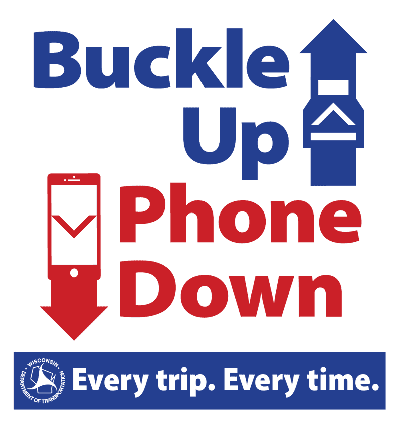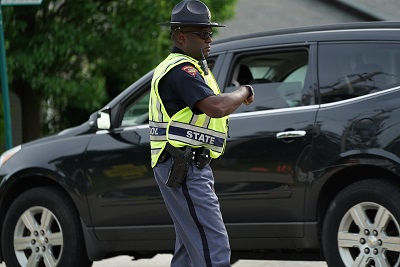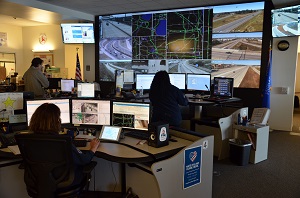Buckle Up Phone Down
The Wisconsin Department of Transportation’s (WisDOT) Buckle Up Phone Down campaign asks everyone to show support for two simple measures: use a seat belt every time you get in the car and stay off your phone while driving.
Cell phone use is one of the biggest distractions while driving. Distracted driving was a factor in almost 9,000 crashes in 2020, including 31 deaths.
WisDOT reports 11% of drivers in Wisconsin did not buckle up in 2020. Unbuckled drivers and passengers made up 44% of all fatalities 2020.
People of all ages in Wisconsin can commit to saving lives by taking the pledge at wisconsindot.gov/BUPD. Participants are encouraged to share a thumbs up/thumbs down photo on social media using the hashtag #BuckleUpPhoneDown then challenge friends, family and coworkers to do the same.
What to do if you're involved in a crash
There are unfortunately thousands of crashes every year throughout the State of Wisconsin. Many of these crashes damage property and may lead to serious or fatal injuries. Additionally, crashes can create risks for other drivers including congestion, debris in the roadway or the blockage of travel lanes.
Being in a crash can be stressful, so it is important for motorists to remain calm.
- Check for injuries and call 911 immediately if anyone’s been hurt.
- Turn on hazard lights and, only if no one is hurt, drive to a safe recovery spot such as a wide shoulder or parking lot.
- When calling 911, be prepared to talk about where the crash is located (nearby crossroads, highway mile posts, direction of travel), the severity of injuries and if traffic lanes are blocked.
- Stay inside the vehicle and away from traffic while waiting for help.
Do you know when to report a crash? Wisconsin law requires that crashes must be reported if they involve injuries, $1,000 or more in damage to a vehicle or personal property, or $200 or more in damages to government-owned property.
Winter driving creates a unique set of challenges in which drivers should always be ready to deal with the unexpected. Visit WisDOT’s information on safe winter driving to learn more about best practices for safe driving in the icy and snowy months.
Protecting first responders
Any crash poses risk to everyone on the road and, tragically, a crash scene can easily become just as dangerous as the crash itself. This is especially true for first responders, and the likelihood of secondary crashes (from “rubbernecking,” distracted driving or any other cause) increases for each minute the primary incident continues to be a hazard on the road.
 Depending on the circumstances of a crash, crash response can often involve any combination of the following:
Depending on the circumstances of a crash, crash response can often involve any combination of the following:
- Law enforcement
- Fire department
- Ambulance service
- Towing/recovery
- Utility companies
- Highway maintenance
Wisconsin averages more than 200 crashes annually involving at least one emergency vehicle that’s engaged in an emergency response.
Make space to stay safe
There are simple precautions all drivers can take to help facilitate safer response and recovery operations on our roadways.
Wisconsin’s “Move Over Law” requires drivers to provide a safety buffer for stopped law enforcement, emergency, maintenance and towing/recovery vehicles.
- If the road has more than one directional lane, like the Interstate, and you can switch lanes safely, you must move over to vacate the lane closest to the vehicle with its lights flashing.
- If the road has a single directional lane or you can't safely move over, you must reduce your speed.
Additionally, Wisconsin’s “Steer It, Clear It Law” was designed to help clear lanes of travel in the event of a crash.
- If a vehicle is operable and nobody is hurt, drivers are required to drive to a location that will obstruct traffic as little as possible, such as a side street, wide shoulder, nearby parking lot or crash investigation site.
- Law enforcement also has authority to quickly remove vehicles, debris and spilled materials.
Wisconsin’s Emergency Response Area law protects first responders by banning cell phone use in an emergency response area and creating new penalties for drivers who injure or kill a worker on the side of the road. The goal is to reduce distracted driving and improve safety for drivers and workers.
- Wisconsin Act 115 defines an emergency or roadside response area as the section of road within 500 feet of an authorized emergency vehicle with a visible signal, or a tow truck with flashing red lights.
- Fines double for certain traffic violations. If a driver causes bodily harm to a worker, they may be fined up to $10,000 or jailed nine months, or both. A court may also order 100 to 200 hours of community service and mandatory traffic school.
Safety starts with you
 Speeding, red-light running, distracted driving: These are all common examples of the dangers that often result in collisions. Being a patient and courteous driver can go a long way in facilitating safety for everyone on the road. Please consider these tips every time you get behind the wheel.
Speeding, red-light running, distracted driving: These are all common examples of the dangers that often result in collisions. Being a patient and courteous driver can go a long way in facilitating safety for everyone on the road. Please consider these tips every time you get behind the wheel.
- Plan ahead to avoid congestion (know before you go with 511 Wisconsin) and provide yourself plenty of time.
- If you must use a phone while driving, stop at a safe area such as a wayside or gas station.
- Remember that hand-held mobile phone use in work zones is illegal.
- If you are making a long drive, consider recording a voice mail message saying how long you’ll be unavailable.
- Eliminate distractions such as eating or putting on makeup.
- Avoid driving when angry, upset or overly tired. There are more than 30 rest areas located throughout the state highway system to help drivers take a break from the road.
Additionally, be prepared. It’s always a good idea to keep a few items in your car to help in the event of a crash or breakdown. These include a visibility vest, a charged mobile phone, a first aid kit, a warm blanket, extra clothing and snacks.
Did you know that crash risk is higher in the first year of driving than at any other time in a person’s driving career? Learn more about the parent-teen safe driving contract.
Creating safer roads
Safety is core to the WisDOT mission, and many steps are taken every day to ensure Wisconsin’s highways continue to improve.
 WisDOT’s Traffic Management Center (TMC) is staffed 24 hours a day, 7 days a week and communicates regularly with sheriffs’ and police departments, fire departments, and the Wisconsin State Patrol, as well as media outlets and construction project managers. The TMC integrates a variety of technologies including dynamic message signs and closed circuit cameras to improve safety and efficiency throughout the state highway system.
WisDOT’s Traffic Management Center (TMC) is staffed 24 hours a day, 7 days a week and communicates regularly with sheriffs’ and police departments, fire departments, and the Wisconsin State Patrol, as well as media outlets and construction project managers. The TMC integrates a variety of technologies including dynamic message signs and closed circuit cameras to improve safety and efficiency throughout the state highway system.
The Traffic Incident Management Enhancement (TIME) program is a collaborative effort among first responders and traffic engineers that helps to reduce the duration and impacts of traffic incidents and improve the safety of motorists, crash victims and emergency responders.
Some of the department’s steps toward safer roads are carried out in the planning, design and construction phases of projects. For example, did you know that some bridges and curves use a specially engineered overlay called a high-friction surface treatment to increase traction and reduce crashes? Visit WisDOT’s safety engineering page to learn more about the methods and best practices to help enhance safety.
Wisconsin is among a number of states that organize highway safety patrol operations to clear traffic incidents, move disabled vehicles and manage other traffic hazards. The safety patrols routinely respond to thousands of incidents and breakdowns every year to help ensure traffic lanes are clear for the greater safety of everyone on the road.